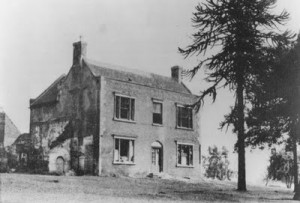By Marri Lynn (W&M Regular Contributor)
Jane C. Webb wrote the The Mummy!: Or a Tale of the Twenty-Second Century when science fiction was still a toddler, very shortly after Mary Shelley’s Frankenstein helped to build the very nursery in which the genre would gain its legs.
When compared to most well-known nineteenth-century science fiction, The Mummy! is short on plot and strength of prose; but when read on its own merits, from the perspective of a historian or author, this oft-overlooked title has a lot to show us.
When it was published in 1827, The Mummy! caught the attention of John C. Loudon, a one-armed recovered opium addict and landscape architect. He was intrigued by the anonymous author’s descriptions of inventive technologies that would serve him and his peers in their careers. Take, for example, a machine that draws down rainclouds for the express purpose of sparing you backbreaking hours with the watering can, or an automated, steam-powered lawnmower that I envision functioning a little like a coal-munching Roomba for your lawn.
Loudon would become intrigued by the author behind the ingenuity, discovering her to be an authoress only after a mutual acquaintance arranged a meeting face-to-face. The mutual acquaintance had unwittingly played matchmaker: Loudon and Webb hit it off, despite their age gap of twenty-four years, and were married eight months after their first rendezvous. This liaison led to the blossoming of Webb’s fascination with gardening and the useful entry-level gardening advice books that came of it. It also meant the simultaneous rot of her budding career as an authoress of science fiction, a career path she had turned to when financial desperation in the wake of her father’s death demanded she find an enterprise.
The Mummy! makes for an excellent study in the historical strengths and limitations of science fiction as a genre. It shows us how technological innovations are entertaining but meaningless when grafted on the back of stagnant social assumptions, even when authors make bold attempts to write above, or around, these extant social constructs by setting their stories centuries into the future. To be convincing, authors must envision social change that seems as fabulous as technological change. What Webb could and could not envision can (and should!) be read not merely as an authorial failing, but rather, as a means to gain insight into the late Georgian-era outlook.
In some ways, Webb’s society of the twenty-second century was very forward-thinking: in an apparent combination of feminism and democracy, England is governed by elected queens; women are free to wear trousers, and universal education is free. But the queen’s speeches and the statements of her supporters draw strongly on Victorian language and sexist ideals of women to justify a queen’s rule. And while trouser-wearing they are, Webb’s women of the twenty-second century are still very prone to getting the vapors and needing a man to wave the smelling-salts under their noses.
Webb took note of the scientific and developmental trends around her, projecting them into the future – sometimes without a full apprehension of their significance. We learn that England’s topsoil has been thoroughly excavated, but rather than crop failure and a battle with erosion, the consequences are a springy turf which seems to amuse the British more than anything else. Webb wisely sensed the looming necessity for a more efficient means of communication across long distances, and pushed her technological imagination into devising a cannon-powered mail system . . . which seems rather disingenuous when you consider her depiction of the sky of the twenty-second century, a place highly trafficked by hot air balloons and more zany leisure and commuter craft than you can wave a zeppelin at.
(Be further warned that in this century, traumatic collisions and blood loss are still treatable by bloodletting.)
While the new generation of casually multilingual Brits enjoy their machine-conditioned air at home, and the convenience of a home telegraph machine, war overseas is still carried out by foot soldiers and horse-riding cavalry with the aid of gunpowder cannons.
But other anticipations of Webb’s were closer to the mark, reflective of the burgeoning technological momentum of the industrial revolution of which we are the inheritors. Leather shoes are stamped out in one pressing at rapid factories, there are steam-powered machines for milking cows, and aerial bridges span the gulfs between England’s new sky-scraping steeples.
Whether Webb’s oversights and lack of craft are redeemed by the novelty of The Mummy! is a matter only resolved by individual reader taste. But what is more interesting to think about, should you peruse the pages of this under-studied classic, are the important examples with which Webb unwittingly provides us, in answer to modern questions: what insights can we find in the retrofuture, as an object of historical inquiry? What does good science fiction of today need in order to be considered timeless in the centuries to come?
Marri Lynn holds an MA in the History of Medicine at McGill University, Montreal (2011). She is currently studying French, while freelancing as a writer and copy editor. You can find out more at her About.me page.

